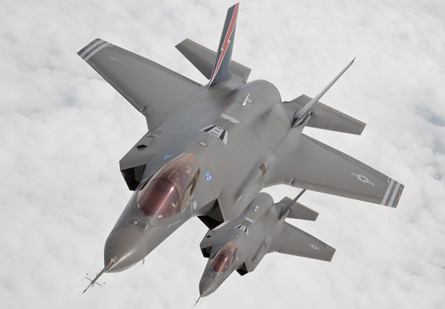A senior Department of Defense official says Lockheed Martin is now on track to reduce the cost of each F-35 by as much as 6.25%, only four months after the programme confirmed a major cost breach.
The remarks by Frank Kendall, principal deputy undersecretary of defense for acquisition, technology and logistics, represent a massive turnaround by the DoD's leadership since reporting a Nunn-McCurdy cost overrun in June and restructuring the programme last February.
Instead, Kendall, addressing the Common Defense (ComDef) 2010 conference on 8 September, cited the F-35 as a key example of what Secretary of Defense Robert Gates means about making the defence industry produce more with less.
"If we can only afford 80 F-35s every year now," Kendall asked, "can we afford 85?"
 |
|---|
© Lockheed Martin |
It is not clear if Kendall was referring to a specific future order or if he was speaking generically, but the US Air Force currently plans to buy 80 F-35As per year at peak rates.
"I don't think that's an unrealistic example," Kendall added. "I think we are on the path to do exactly that."
Kendall's fresh dose of optimism on F-35 costs comes as DoD and Lockheed officials continue protracted negotiations over the fourth yearly contract for low rate production. Lockheed has agreed to convert contract terms from a "cost-plus" to fixed-price-incentive fee structure two years earlier than scheduled, but the details have delayed contract signing by at least three months.
In late May, the DoD reported that internal cost projections have soared since 2002, with the average cost of each Joint Strike Fighter rising from $50 million to $92.4 million over that period. The cost overrun was blamed on several factors, including the US Navy's decision in 2002 to slash orders by 409 jets, inflation and unexpected labour and manufacturing cost increases.
At the time, a senior DoD official told reporters that "we're going to scrub every column of cost in this programme and try to restore it as a close as possible to what a decade ago the department said it was going to cost".
Lockheed officials have consistently maintained that DoD cost projections for the F-35 programme were inaccurate, with internal estimates being as much as 20% lower.
Part of the DoD's restructuring plan last April called for Lockheed to adopt a buy-to-budget strategy. In particular, it slashed five of the 48 jets in next year's budget, but Lockheed could still deliver all 48 for the same price as 43.
Source: Flight International
















